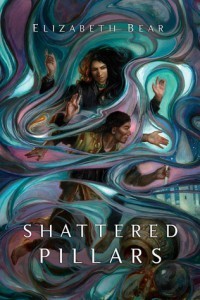date newest »
newest »
 newest »
newest »
 I know, I know, I really need to try more by Sagara / West. I probably even have this sitting on my TBR pile. Someday . . .
I know, I know, I really need to try more by Sagara / West. I probably even have this sitting on my TBR pile. Someday . . .
 I haven't read Elizabeth Bear's series yet (I waited until all three came out, and now I'm waiting for a good long time to immerse in three books) but I love how she's done omniscient POV in the past.
I haven't read Elizabeth Bear's series yet (I waited until all three came out, and now I'm waiting for a good long time to immerse in three books) but I love how she's done omniscient POV in the past.
 Would you say omniscient pov is the same as multiple pov that switch frequently? Because I would have said that omniscient is "inside the head" of multiple characters at the same time, which is different. I do admire authors who can handle a real omniscient narrative. It looks impossible to me.
Would you say omniscient pov is the same as multiple pov that switch frequently? Because I would have said that omniscient is "inside the head" of multiple characters at the same time, which is different. I do admire authors who can handle a real omniscient narrative. It looks impossible to me.
 Just like there are several kinds of first person (like Flaubert and Joseph Conrad in which the first person still knows the thoughts of others) there are distant firsts--and distant third and omniscient. Virginia Woolf did a distant omniscient. There are omni narrators onstage and off, hovering and breaking the fourth wall--all over the map!
Just like there are several kinds of first person (like Flaubert and Joseph Conrad in which the first person still knows the thoughts of others) there are distant firsts--and distant third and omniscient. Virginia Woolf did a distant omniscient. There are omni narrators onstage and off, hovering and breaking the fourth wall--all over the map!
 Sure, but all of them mingle multiple pov in most or some scenes, wouldn't you say? Which is not quite the same as having a dozen pov characters and switching back and forth. Or is it?
Sure, but all of them mingle multiple pov in most or some scenes, wouldn't you say? Which is not quite the same as having a dozen pov characters and switching back and forth. Or is it?
 Well, it just depends on the narrative--you can have Tolkien, for example, sliding in and out of a fox's POV for a single line, then sticking to Frodo's POV for chapters--Tolstoi 's W&P had hundreds of characters, about a tenth of whom get POVs, sometimes shifting rapidly in a scene, sometimes sticking with one character.
Well, it just depends on the narrative--you can have Tolkien, for example, sliding in and out of a fox's POV for a single line, then sticking to Frodo's POV for chapters--Tolstoi 's W&P had hundreds of characters, about a tenth of whom get POVs, sometimes shifting rapidly in a scene, sometimes sticking with one character.Whether the narrator comes into close into intimate space or stays outside except for a quick dive into POV (like Jane Austen did with male POVs in her novels, leading some readers to an erroneous conviction that everything is from the female POVs) so depends!






Not to mention the awesome Jody Lee covers ^^ - and the arc of the Sunsword is complete (although not everything is resolved).